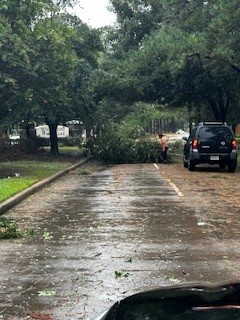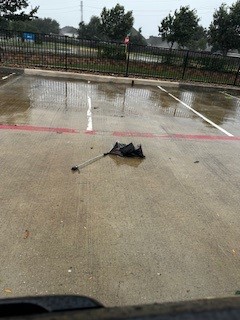Hurricane Season in Houston: AI-Powered Disaster Recovery for Floods

Disaster relief organizations recognize their pivotal role in supporting communities during natural disasters such as hurricanes, tornadoes, and wildfires. Hurricane season in Houston, Texas, presents a unique set of challenges. The Atlantic hurricane season, officially lasting from June 1 to November 30, brings a heightened risk of major hurricanes and tropical storms, often leading to devastating floods in the area.
The National Hurricane Center (NHC) at the National Oceanic and Atmospheric Administration (NOAA) closely monitors weather patterns in the Atlantic, Caribbean Sea, and Eastern Pacific Ocean, issuing forecasts and warnings to help communities prepare.
While hurricanes can cause significant damage, their heavy rainfall is often the most catastrophic consequence, considering Houston’s unique geography. The city’s network of bayous, creeks, and low-lying areas makes it particularly susceptible to flooding during hurricane season.
Analyzing the case of Houston, we’ll explore how disaster relief organizations can utilize AI technology to prepare for and respond to floods during hurricane season. We’ll also explore the importance of secure, efficient storage solutions and why a seemingly unconventional location like Jersey City can be a strategic choice to be prepared for these events.
What Month Has the Most Hurricanes in Houston?
The peak of hurricane activity for the Atlantic basin, which includes the Gulf of Mexico and the Texas coast, typically falls between mid-August and late September. During these months, the warm sea surface temperatures in the Main Development Region (MDR) create ideal conditions for tropical systems to develop and strengthen into hurricanes.
While the NHC’s seasonal forecasts cannot predict the exact number of landfalling hurricanes, they offer valuable insights for disaster relief organizations. By staying informed about these future events and monitoring real-time weather data, these organizations can proactively plan hurricane preparedness for potential rain, storm, and flooding events that may hit the area.
What Part of Houston Floods the Most?
Predicting the exact areas most susceptible to flooding during a Houston hurricane season is challenging. However, some areas are statistically more prone to experiencing floods due to Houston native factors like lower elevation and proximity to waterways.
By tracking hurricanes and forecasting their expected landfall, disaster relief organizations can use historical flood data and digital elevation maps to identify the areas most likely to experience severe flooding.



How Can Disaster Relief Companies Prepare for Hurricane Season in Houston?
Understanding the impact of climate change on hurricane formation helps relief organizations and city planners better prepare for and respond to the challenges posed by increasingly severe hurricanes. Warmer sea surface temperatures have led to more intense hurricanes, necessitating greater preparedness.
These organizations have a synergistic relationship with NOAA, enabling them to manage and respond to hurricane season effectively. Through mutual support and collaboration, disaster organizations can utilize NOAA’s scientific expertise and data capabilities to enhance preparedness, response, and recovery efforts in the U.S.
By utilizing AI technologies, they can forecast critical conditions, generate early warning systems, and create strategic plans. Through this collaboration, the city can enhance hurricane preparedness to minimize the aftermath of these extreme events.
Demand forecasting:
AI algorithms can analyze historical data on past hurricane seasons, average rainfall patterns, and flood events in the Houston area. By processing this data, AI can predict the potential demand for recovery services in different parts of the city.
Having this information in advance allows for the pre-allocation of resources and personnel to areas with the highest predicted flood risk in different areas. This enables the city to place essential resources like sandbags, pumps, and rescue boats in high-risk areas, ensuring a faster and more effective response to inundation.
Additionally, it allows authorities to warn residents of these areas so they can secure their properties properly. Homeowners can reinforce their doors and windows and prevent water from entering their homes.
Resource optimization:
AI can analyze data on available resources, such as personnel, equipment, and supplies, and optimize their deployment based on forecasted flood patterns. Optimizing resources ensures recovery efforts reach the areas that need them most quickly.
Route planning and logistics:
AI-powered logistics software can be used to plan the most efficient routes for deploying disaster recovery teams and equipment in flooded areas. This planning helps minimize response times, strengthens points of contact with specific areas, and ensures that critical support reaches those in need as quickly as possible by improving access and allowing recovery teams to reach affected locations more easily.
Forecasters also enable teams to predict which areas are most likely to have storm debris, such as fallen trees and shrubs, that may block access.
Real-time monitoring:
AI-driven solutions create platforms that facilitate real-time information sharing among disaster relief teams, government agencies, and affected communities. These platforms can manage large volumes of data and deliver relevant information to the right people at the right time.
These capabilities ensure continuous updates on the hurricane’s course, enabling timely and effective intervention. For example, if certain areas must be evacuated, relief teams can arrive promptly to save lives.
What Kind of Storage Solutions Does a Disaster Relief Company Need?
Finding efficient and reliable storage solutions is crucial for disaster relief organizations. Here are some key considerations:
Centralized location:
Ideally, the storage facility should be centrally located within Houston or the surrounding area to minimize travel times when deploying resources during a flood event. Accessibility is paramount, especially in a situation where roads may be blocked or damaged.
Climate control:
The storage facility should offer climate-controlled options to protect essential supplies and equipment from extreme summer temperatures and humidity. Specific tools and equipment may be sensitive to weather conditions, and proper storage is vital to ensure they are functional when needed.
Security:
The storage facility should also have robust security measures to protect valuable disaster recovery equipment and supplies from theft or vandalism. Disaster relief supplies are crucial during a crisis, and their security is paramount.
Finding a warehouse that meets these criteria can be challenging, especially during hurricane season when demand for storage space can surge. However, there are some additional factors disaster relief companies can consider.
“We provide warehousing services to support disaster relief companies to pick-up from site as well as additional warehouse space for sorting and storage while remediation takes place,” says Tom Pera, President of Armstrong Houston. “Our local delivery service is available to deliver back to site so you can focus on getting Houston running again.”
Why Jersey City is a Good Storage Site for Disaster Relief Organizations
While Houston itself seems like a logical choice for storage during hurricane season, there are some advantages to considering alternative locations. Here’s why Jersey City can be a strategic storage solution for disaster relief organizations preparing for Houston floods:
- Reduced Risk: Jersey City is geographically removed from the direct path of most hurricanes that generally threaten Houston. While not immune to tropical storms, the risk of a hurricane causing significant damage in Jersey City is considerably lower. Fewer major hurricanes reduce the likelihood of your stored supplies being directly impacted, ensuring their availability for deployment to Houston after the storm passes.
- Accessibility: Jersey City boasts excellent transportation infrastructure, including major highways and international airports. This accessibility allows for swift and efficient transportation of disaster relief supplies to Houston by land or air when needed. Even if some transportation routes to Houston are disrupted by flooding, alternative options from Jersey City are more likely to remain operational.
- Warehouse Availability: Warehousing space in Houston can become scarce and expensive during hurricane season. Jersey City may offer a broader range of warehousing options at potentially more competitive rates, allowing relief organizations to secure the necessary storage space at affordable prices.
- IWLA Certification: The International Warehouse Logistics Association (IWLA) is a non-profit organization that sets standards for high warehousing and logistics practices. Many warehouses in Jersey City are IWLA-certified, demonstrating their commitment to security, efficient operations, and adherence to industry best practices. Choosing an IWLA-certified warehouse in Jersey City gives you peace of mind, knowing your disaster relief supplies are stored in a safe and reliable facility.
Leveraging AI for Streamlined Operations:
Disaster relief organizations storing supplies in Jersey City can further enhance their preparedness by utilizing AI technology for warehouse management:
- Inventory Management: AI-powered warehouse management systems can track inventory levels in real-time, ensuring you have a clear picture of the supplies available for deployment to Houston. Constantly updated inventory management enables proactive restocking and eliminates the risk of critical supplies being unavailable when needed.
- Predictive Maintenance: AI can analyze sensor data from warehouse equipment to predict potential maintenance issues. By addressing these issues proactively, you can minimize downtime and ensure your warehouse operations run smoothly, guaranteeing a swift response when Houston calls upon your resources.
Utilizing Technology for Effective Disaster Relief
Hurricane season in Houston, Texas, presents a significant challenge for disaster relief organizations. By leveraging AI technology for planning and preparation and considering alternative storage solutions like Jersey City, these organizations can enhance their ability to respond effectively to hurricanes’ aftermath.
By optimizing resources and ensuring availability, they can play a crucial role in helping Houston communities recover from the devastation of natural disasters.
Learn about Armstrong’s logistics and warehousing services. Discover our moving, storage, and logistics solutions in Houston and store resources appropriately. Stay prepared for hurricane season!
